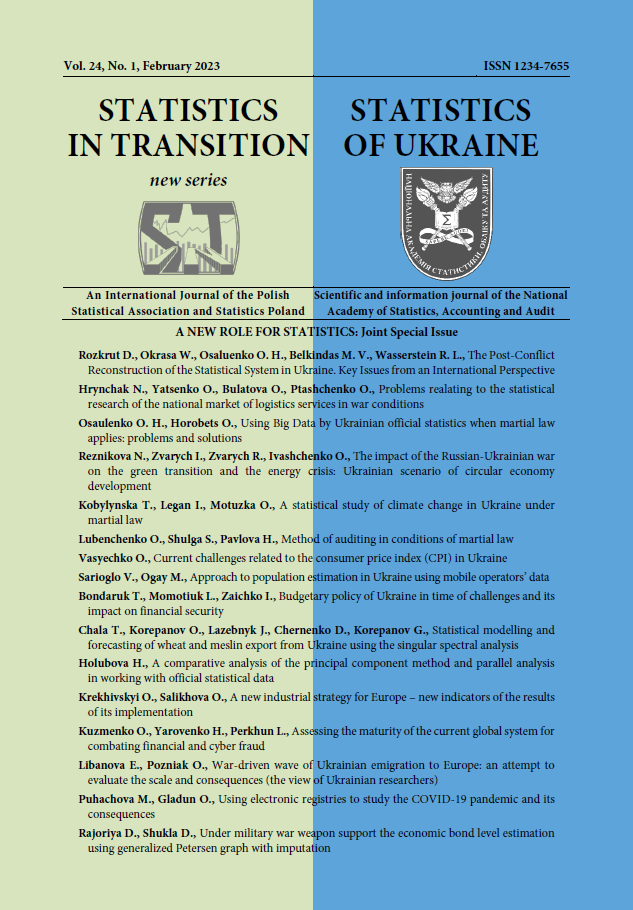ARTICLE
ABSTRACT
The purpose of this study is to contribute to the maintenance and compilation of the consumer price index (CPI) in the current extreme situation caused by the Russian military aggression against Ukraine. In these extreme conditions, official statistics is faced with the task of maintaining the regularity, completeness and quality of the production of statistical information, including the CPI, which is one of the key economic indicators. The interaction between the ideal and conditional concepts of the index and their practical implementation is considered as a potential source of compilation improvement. The author argues that the main factor of the modern criticism of the CPI is the systematic deviation of the practical form of the index from its theoretical foundations. One way to solve this problem is to use new sources of information, especially big data cash registers. In today's extreme conditions, cash data can extensively address the issue of limited and untimely access to primary data sources needed to compile the CPI, as well as promptly take into account the changes in consumption patterns caused by significant migratory flows from the dangerous areas, and changes in the supply offer due to the rupture of supply chains.
KEYWORDS
consumer price index (CPI), Russian military aggression against Ukraine, ideal concept of CPI, conditional concept of CPI, cash registers, Big Data.
REFERENCES
Balk, B. M., (2004). Direct and chained indices: a review of two paradigms. URL: https://www.researchgate.net/publication/228443023_Direct_and_chained_indice s_a_review_of_two_paradigms.
Balk, B. M., (2018). Mixed-form indices: a study of their properties. URL: https://ec.europa.eu/eurostat/cros/system/files/euronaissue1-2018-article3.pdf.
Chauvet-Peyrard, A., (2013). Les indices de prix. De la théorie a la pratique. URL: https://dokumen.tips/documents/cours-les-indices-de-prix-de-la-theorie-a-lapratique- acp-version-publique-2013.html.
Chessa, A. G., (2016). A new methodology for processing scanner data in the Dutch CPI. URL: https://ec.europa.eu/eurostat/cros/system/files/euronaissue1-2016-art2.pdf.
Consumer price index manual. Concepts and Methods – 2020. International Labour Office. International Monetary Fund. Organisation for Economic Co-operation and Development. European Union. United Nations. World Bank.
Diewert, W. E., (1995). On the Stochastic Approach to Index Numbers. Document of discussion, no DP 95-31, University of British Columbia.
Diewert, W. E., Hill, R. J., (2010). Chapter 12 Alternative approaches to index number theory. Price and productivity measurement: Volume 6 – Index Number Theory. URL: http://www.indexmeasures.ca/Vol6_10,09,26.pdf.
Diewert, W. E., (1995). Axiomatic and economic approaches to elementary price indexes. NBER Working Paper, No. w5104.
Diewert, W. E., (1976). Exact and superlative index numbers. Journal of Econometrics, 1976, vol. 4, issue 2, pp. 115–145.
Export and import price index manual: theory and practice, (2009). International Monetary Fund, Washington, D.C.
Guide complémentaire du Manuel de l'indice des prix a la consummation, OIT, (2004). URL: http://www.imf.org/external/data.htm#guide.
Hill, T. P., (2010). Lowe indices. Price and productivity measurement, Vol. 6, pp. 197–216.
Hulten, Ch. R., (2008). Divisia index. The New Palgrave Dictionary of Economics, 2nd ed.
Konny, C. G., Williams, B. K., Friedman, D. M., (2019). Big Data in the U.S. Consumer Price Index: Experiences & Plans. URL: https://www.nber.org/books-andchapters/ big-data-twenty-first-century-economic-statistics/big-data-usconsumer- price-index-experiences-and-plans.
Leclair, M. et al., (2019). Utiliser les données de caisses pour le calcul de l’indice des prix a la consummation. Courrier des statistiques, 3, pp. 61–75.
Léonard, I., Sillard, P. & Varlet, G., (2019). Écarts spatiaux de prix dans l’alimentaire avec les données de caisse, Economie et Statistique/Economics and Statitistics, 509, pp. 73–87.
Manser, M. E., McDonald, R. J, (1988). An Analysis of Substitution Bias in Measuring Inflation, 1959-85, Econometrica, Vol. 56(4), pp. 909–930.
Reis, R., (2009). A dynamic measure of inflation. NBER. URL: https://www.nber.org/papers/w11746.
Sillard, P., (2017). Indices de prix a la consommation. Insee, Document de travail, N°F1706.
State Statistics Service of Ukraine, (2016). Metodolohichni polozhennia shchodo orhanizatsii statystychnoho sposterezhennia za zminamy tsin (taryfiv) na spozhyvchi tovary (posluhy) I rozrakhunkiv indeksiv spozhyvchykh tsin [Methodological guidance on organization of statistical observation of change in prices (tariffs) on consumer goods (services) and calculation of consumer prices indices]. URL: http://ukrstat.gov.ua/norm_doc/2021/310/310.pdf [in Ukrainian].
Stoevska, V., (2018). Official consumer price indices – historical perspective, ILO Department of Statistics. URL: https://unece.org/fileadmin/DAM/stats/documents/ece/ces/ge.22/2018/ILO.pdf.
The World Bank Consumer price index manual, (2004). Theory and practice, Geneva, International Labour Office.
Von Auer, L., (2004). Economic monotonicity of price index formulas. Otto-von- Guericke-Universität Magdeburg. URL: http://www.ipeer.ca/papers/Auer,Nov.04,RevisedCommentSSHRC46.pdf.
